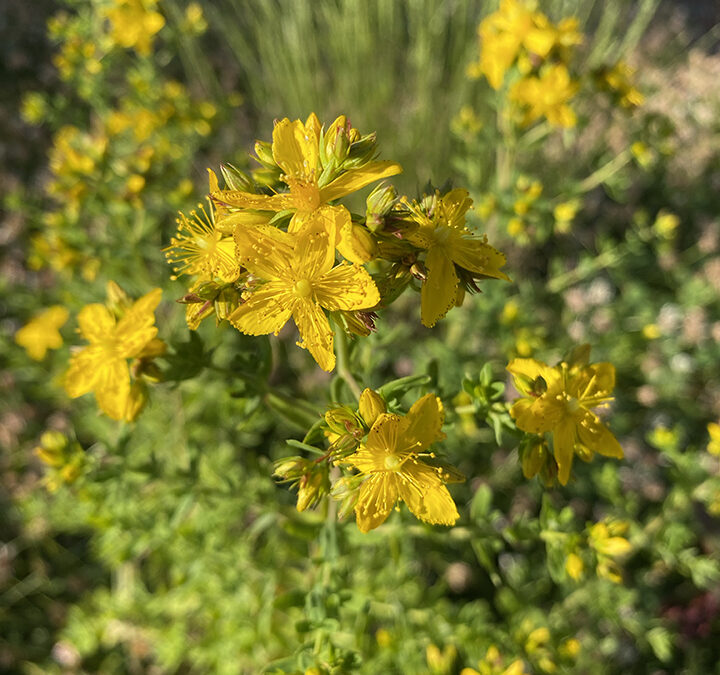Let’s talk about St. John’s Wort: The Herb That Lets the Sun Shine In
I lived with my mom when I was a teenager, but my dad would wake up early every day to pick me up and drive me to school. Self-centered youth that I was, I would force the poor man to listen to the raucous, ad-heavy indoctrination of the Morning Zoo on the local pop radio station.
I know he would’ve preferred to chat, listen to jazz or Rage Against the Machine, sit quietly in each other’s company, —or pretty much anything other than the constant product-placement and stupid jokes you hear on early-morning radio!— but I wouldn’t have it any other way. (Sorry Papa, I get it now.)
It was in one of these not-so-subtle product-placement bits that I was first introduced to St. John’s Wort, but as the host was talking about how he started taking St. John’s Wort to help lift his mood and relieve depression, all I could think about was skin warts. (Ew. You too?)
Little did I know that this dainty herb with a funny name would later become a good friend of mine.
Fast forward about 10 years, and I found myself doing an internship at the Herb Pharm in Williams, Oregon, face-to-face with her beautiful yellow blossoms.
There’s a lot to love about St. John’s Wort.
St. John’s Wort (or, more formally, Hypericum perforatum) always blooms toward the end of June, right around summer solstice, the sunniest day of the year, and her happy yellow blossoms look like sunshine in a flower.
You’ll find St. John’s Wort growing in the cracks and crevices of concrete on the side of the road, or in arid fields, surrounded by other hearty survivors like yarrow, queen Anne’s lace, plantain, and the grasses. I love this about her, because it reflects both her ability to help you thrive in challenging situations, as well as connect with others socially.
Another fascinating feature of this lovely little herb: If you take one of her leaves and hold it up to the sun, you’ll see small holes that let the light shine through.
And this is exactly what St. John’s Wort does.
This astringent, sweet, and bitter herb is gently warming and helps to bring lightness to your heart while soothing the nervous system.
In her book Herbal Medicine from the Heart of the Earth, Dr. Sharol Marie Tilgner talks about using St. John’s Wort for sharp pain and inflammatory conditions, in addition to the most famous effect: treating mental health conditions like depression, fear, insomnia, anorexia, anxiety, and feelings of worthlessness.
St. John’s Wort is associated with the solar plexus chakra, which resides in the center of the body, right above the navel, and is associated with the Ego and sense of self. This explains, in part, why it is so helpful in helping people find direction, purpose, and joy in their being. This location in the body is also where the stomach sits, and it is no coincidence that St. John’s Wort can therefore improve the assimilation of food, and also our ability to take in and be nourished by the world around us.
Matthew Wood explains in his book, The Book of Herbal Wisdom, Using Plants as Medicine, that “the Greek name for this plant was hypericon. This seems to indicate that it was placed ‘above the icon,’ or possibly that it had power ‘over the image,'” and perhaps, therefore, allows us to move past the Ego toward a more open and honest sense of self.
And in Medicinal Plants of the Pacific West, the Herbalist Michael Moore describes St.John’s Wort this way:
“Hypericum is one of our best herbal therapies for depression and numbing frustration. It seems to work best for those people, especially men, who find things falling apart but who really have little life experience with failure or loss of confidence…their life needs new approaches, they are stuck in a rut, spinning their wheels, and feeling growing frustration and depression with their problems.”
How to Use St. John’s Wort
If you’d like to try St. John’s Wort for yourself, I recommend starting with 10 drops of fresh leaf and flower tincture, 2-3x/day*. You should feel the effects in about 2-6 weeks, and then you may want to reevaluate.
(My favorite tinctures are made by one of my teachers, Scott Kloos, at Cascadia Folk Medicine, but if you can’t find it there, Herb Pharm is a great alternative. BTW, I have no affiliation with either of these, they are just the brands I most trust and have personal experience with.)
The oil can also be used topically.
When mixed with arnica oil, St. John’s Wort can be an effective remedy for sciatica, TMJ, and other physical conditions with inflamed nerves.
In pregnancy, St.John’s Wort oil can have a protective quality when used to massage the belly and breasts, and can also be used to prepare the perineum for birth.
That said, it’s always a good idea to work with a trained herbalist if you want to find the herbs and formulas that are best suited to you right now. Herbal medicine might be gentle, but it can have side effects just like anything else you put in your body. Plus, if you’re going to spend the money on it, you want to up the odds that it’ll work!
Also, be aware that St. J’s really does let the sun shine into all aspects of your being, so you may become more photosensitive and more likely to get a sunburn when using it! Make sure you wear sunscreen and stay in the shade even more than you would otherwise if you’re taking this herb.
*Who shouldn’t use St. John’s Wort?
You shouldn’t use St. J’s if you’re pregnant, nursing, or taking prescription drugs, especially SSRIs or MAO inhibitors.
Please check with your doctor before starting this or any other herbal protocol.
Next Steps
Click here to download the 15 Best Herbs for Anxiety.
This (free) guide will teach you which herbs to use to treat different types of stress and anxiety.
I can’t wait to see where it takes you!





